|
For years here on Daizenshuu EX, we hosted a section called "There is no OVA!" Immediately after clicking through to the page, you would read an amusing retraction of that statement. Toward the end, we explained that there was just so much more than the "OVA" itself, and that the entire thing became something larger than expected into a sort of "fanboy legend".
That specific page sufficed until 2010, a full seventeen years after the first release of Saiya-jin Zetsumetsu Keikaku. With the upcoming release of Raging Blast 2 on the horizon, it made sense to tweak the section, incorporate new information, and re-launch the page. Already confused? We do not blame you. Keep reading!

In August 1993, a game was released for the Nintendo Famicom (NES) in Japan entitled Gaiden: Saiya-jin Zetsumetsu Keikaku (Side Story: The Plan to Eradicate the Saiyans). The plot revolved around a Tsufuru-jin, the supposed Saiyan-homeworld co-inhabitants, seeking revenge for their destruction, primarily through the "Destron Gas" which is quickly killing all living things on Earth. All of this amplified hatred toward the Saiyans is the product of a machine called "Hatchihyakku", which itself is responsible for "Ghost Warrior" versions of prior villains, as well as "Dr. Raichî" (sometimes "Lychee"), who at first appeared to be the main villain of the story. Goku and friends ultimately save the day, much like any self-respecting DragonBall game or feature presentation.
06 August 1993
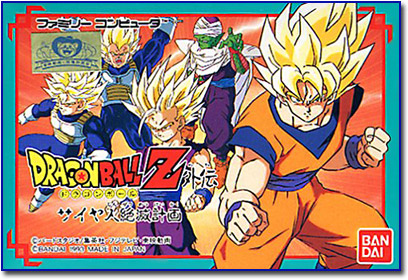
ドラゴンボールZ外伝 サイヤ人絶滅計画
Doragonbôru Z Gaiden: Saiya-jin Zetsumetsu Keikaku
DragonBall Z Side Story: The Plan to Eradicate the Saiyans
While other games had certainly incorporated new elements into the larger, canonical story from the original manga and TV series (and sometimes movies), this was one of the first games to go with a completely new, never-before-told story. Done in the traditional card-battle style of the time, it was one of the later games released for the Famicom, actually coming out after the Super Famicom (SNES) had already been released!
That same month, two VHS volumes were released to complement the video game, called "Official Visual Guides" (公式ビジュアルガイド / kôshiki bijuaru gaido). These videos were fully-animated, voice-acted, and musically-scored feature presentations that acted as a sort of "strategy guide" for the game. They showcased the correct paths to take (including brief cut-aways to the actual Famicom game's map screen), techniques to use, and order of events to play through. Released in two parts (Jôkan / Part 1, and Gekan / Part 2), these "Visual Guides" were, simultaneously, somewhat of an "OVA" for the franchise. A synopsis of the entire story can be read in our "Movie Guide".
August 1993
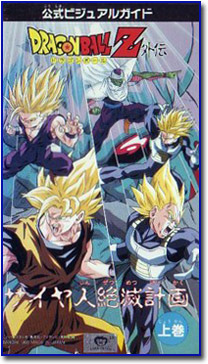 ドラゴンボールZ外伝 サイヤ人絶滅計画 上巻
Doragonbôru Z Gaiden: Saiya-jin Zetsumetsu Keikaku Jôkan
DragonBall Z Side Story: The Plan to Eradicate the Saiyans: Part 1
ドラゴンボールZ外伝 サイヤ人絶滅計画 上巻
Doragonbôru Z Gaiden: Saiya-jin Zetsumetsu Keikaku Jôkan
DragonBall Z Side Story: The Plan to Eradicate the Saiyans: Part 1 |
August 1993
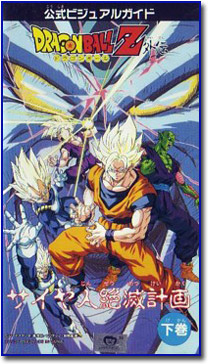 ドラゴンボールZ外伝 サイヤ人絶滅計画 下巻
Doragonbôru Z Gaiden: Saiya-jin Zetsumetsu Keikaku Gekan
DragonBall Z Side Story: The Plan to Eradicate the Saiyans: Part 2
ドラゴンボールZ外伝 サイヤ人絶滅計画 下巻
Doragonbôru Z Gaiden: Saiya-jin Zetsumetsu Keikaku Gekan
DragonBall Z Side Story: The Plan to Eradicate the Saiyans: Part 2 |
The features even received their own soundtrack release on 21 October 1993 (FMCC-5006; 11 tracks, 45 minutes). Interestingly, all musical tracks are titled in proper English.
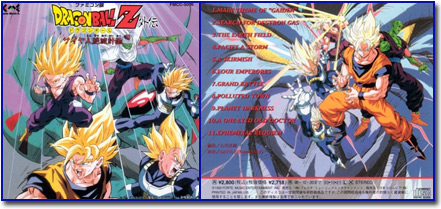
Image Courtesy of Ginga Giri Giri Kai (www.3gkai.com)
What exactly is an "OVA", though? In today's digital-delivery-based world of consumption, the idea of something being released to "home format" almost no longer makes any sense. We still have examples of them in the anime industry, but they are quickly becoming a relic of our pre-digital past.
An OVA (or sometimes OAV) is an "Original Video Animation" (or if swapped around, "Original Animation Video"). OVAs are generally higher-budget productions, and are always released straight to home format. Although they may later find themselves with TV airings, their initial release is straight to a home format, whether that be VHS or DVD (depending on the time period of its release) — this release style is the sole factor that categorizes them. It does not matter if it is based on a manga, a re-make of a previously-existing anime, a sequel, or an original feature — if this particular item was released to a home format first, it is an "OVA".
Some of the more popular OVAs have been those of the Ranma 1/2 and Fushigi Yûgi series, in these cases being continuations of pre-existing series to home format instead of television. There are also complete series such as Blue Sub. 6 and Ah, Megami-sama! (Oh, My Goddess!), the latter of which was ultimately re-made into a new TV series. OVAs have become something of a lost-art in the last few years, with only a few notable releases such as Hellsing Ultimate in favor of standard TV releases, possibly due to the reduced-cost of digital animation over traditional, cel-based animation by hand.
So what we do call the darn thing...? There was a Famicom game, and then a two-part video feature that could stand on its own, sure... but it was also intended as a guide for that video game. Before we can categorize it, there is some additional history to toss into the mix.
Most people familiar with the Japanese version of the franchise know that in Japan, Bandai is the company responsible for the plethora of DragonBall video games. From their Mystery of Shenlong (Dragon Power in the US) Famicom game, all the way through the current Raging Blast series and beyond, Bandai has been the publisher behind them all.
In 1994, two DragonBall games were released for a system that few people in the US have even heard of: the Playdia, a so-called "Quick Interactive System" released by Bandai, themselves:
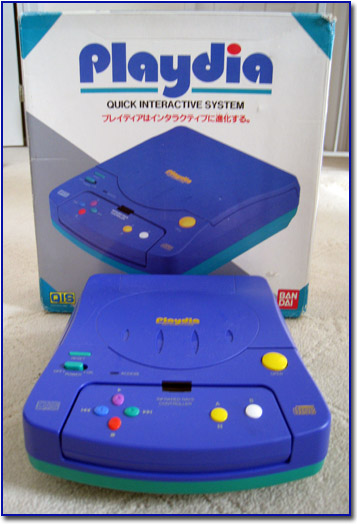
In the age of the new Sony PlayStation and Sega Saturn in 1994, it would seem odd for a company like Bandai to suddenly throw their own new console into the mix; it was odd. The system was marketed as a "family" console and toward a younger audience. Imagine the image of the Nintendo 64 ("The Fun Machine") or Wii in America with the physical style of the Super Famicom in Japan, make it CD-based, and you have your Playdia. The system even came with and used a wireless controller, a pack-in standard which was virtually unheard of until Microsoft took the hint in the next decade.
Rather than traditional console gaming, the Playdia was based more on FMV ("full motion video"; similar to most early Sega CD games) and menu-based games — press a button, something happens, and you continue to watch.
Other games based on popular anime were released (such as Sailormoon and Gundam). As to be expected, however, the system did not do all that well. Bandai eventually supplemented their system's catalogue with a few "Idol" games featuring popular voice actresses and performers of the time.
The release of two DragonBall games for the system is where our history gets more interesting, if not hilariously convoluted.
September and December of 1994, respectively, saw the release of parts 1 and 2 of Gaiden: Shin Saiya-jin Zetsumetsu Keikaku (Side Story: True - The Plan to Eradicate the Saiyans): Uchû-Hen (Space Chapter) and Chikyû-Hen (Earth Chapter). The first DragonBall Z game is actually "honored" (to some degree) with the distinction of being the first catalogued Playdia game, with the number "BAPD-01". Both games retailed for ¥4800.
23 September 1994
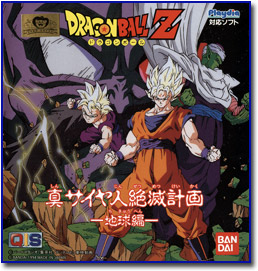 ドラゴンボールZ外伝 真サイヤ人絶滅計画 地球編
Doragonbôru Z Gaiden: Shin Saiya-jin Zetsumetsu Keikaku Chikyû-Hen
DragonBall Z Side Story: New - The Plan to Eradicate the Saiyans: Earth Chapter
ドラゴンボールZ外伝 真サイヤ人絶滅計画 地球編
Doragonbôru Z Gaiden: Shin Saiya-jin Zetsumetsu Keikaku Chikyû-Hen
DragonBall Z Side Story: New - The Plan to Eradicate the Saiyans: Earth Chapter |
16 December 1994
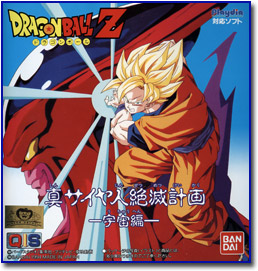 ドラゴンボールZ外伝 真サイヤ人絶滅計画 宇宙編
Doragonbôru Z Gaiden: Shin Saiya-jin Zetsumetsu Keikaku Uchû-Hen
DragonBall Z Side Story: New - The Plan to Eradicate the Saiyans: Space Chapter
ドラゴンボールZ外伝 真サイヤ人絶滅計画 宇宙編
Doragonbôru Z Gaiden: Shin Saiya-jin Zetsumetsu Keikaku Uchû-Hen
DragonBall Z Side Story: New - The Plan to Eradicate the Saiyans: Space Chapter |
The games were just like the other Playdia games — press a button, and something happens in FMV. The video, while at a low frame rate, is very watchable and impressive enough for the time.
At this point, careful readers will begin to piece together the puzzle.
The footage used in the two Playdia games is the exact same footage released to home video as the "Official Visual Guides" a year earlier — it is slightly more pixelated in its compression for the video game system, but it is still the same footage. At the same time, the Playdia games feature an extensive amount of footage not seen in the "Official Visual Guides", since it is very possible (and likely) for a player to wander off the beaten path, visit irrelevant locations, battle enemies in the "wrong" order, etc.
So how did the footage from this game end up being called an OVA? While footage from the Playdia games (and specifically that of their alternate paths and extra endings) have become more widespread in recent years thanks to the rise of services such as YouTube, the footage that most fans refer to as the "OVA" is actually that from the "Official Guide Guides" VHS release. Is this really an OVA, though?
In the technical sense, it is — the footage was released straight to home video, regardless of its sub-classification as a guide for a video game. Toei occasionally refers to it as an "OVA" in production history listings, but the phrase "OVA" was most known to American anime fans in the sense described earlier in this article. Most fans were completely unaware that the story originated in a Famicom game from 1993, never mind having an extensive history with a VHS release and then with footage re-used in another series of video games in 1994!
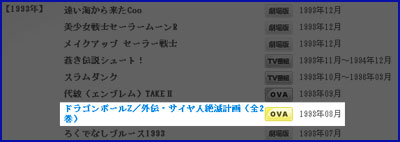
(SOURCE: http://www.toei-anim.co.jp/lineup/gen/1990-1999/)
Sadly, no exact dates are available for the home release of these two "Official Visual Guide" parts. Even by Toei's database, the best we can get is that they were released some time in August 1993.
Back in the day before digital fansubs were as common as they are, "Carddass" (whom really old fans will remember as Gokou3, the owner of the Paozu Yama fansite) timed out the translations for a copy of the footage on VHS, which he eventually handed over to Ramza (owner of a fansite named Dragon Ball Blast). In the winter of 2000, Ramza completed the subtitling of the footage and released it as the "DBZ OVA" on VHS.
The subtitles left a lot to be desired. The font was incredibly difficult to read (there is not much of a border around the yellow subs), and the overall video quality itself was poor. The grammar was not always fantastic, either, with various punctuation errors and amateur mistakes. The screen blips out to garbage about three times. There is a lot of bending at the top of the screen, and lots of discoloration throughout the entire feature. Ramza later went back and redid the subtitling with better-looking subs and a completely re-timed script, but by this point the lower-quality copy had already made its rounds
The term "OVA" to describe the footage (ignoring its Japanese classification) probably originated in its original translators and distributors in the US (being Carddass and Ramza, mentioned above), in combination with listings from Toei. Many DBZ fans from the mid-to-late-90s actually did not know the difference between the Playdia games and the VHS releases — in fact, some thought they were one-in-the-same, further complicating the origin story.
As a shock to fans, Toei Animation included the footage in its entirety as an extra on their second DragonBall Z "Dragon Box" set in Japan in 2003. While the footage for this feature was not remastered as the rest of the series was, it finally received another release on a decent home format.
The footage was occasionally described and mentioned in Japanese reference material, but not nearly as often as the movies proper. The sixth daizenshuu ("MOVIES & TV SPECIALS") dedicated a two-page spread to the footage, its history, its story, and its characters... but beyond that, it has almost always just been a footnote in DragonBall franchise history.
For sixteen-to-seventeen years, that was the story. With the inclusion of the footage as an extra on the Japanese "Dragon Box", and with no international license of the games, their story, or their associated footage, it was something of a "lost movie" to many fans. Only those with the incredible dedication to dive into websites such as this would even have a chance to hear about it. Names like "Dr. Raichî" and "Hatchihyakku" would pop up in fan discussions from time to time, but without the full context presented on a page like this, it was almost not even worth getting into.
Much like we were able to exclusively break the news on the then-upcoming DragonBall Kai in 2009, a source going by the name of "Wasted Wisher" popped in for us on 15 May 2010 to say:
So, I reckon that there's going to be a new Dragonball game coming out, not that I can get in on the fun since I don't have any of the current-gen game systems yet (still on my PS2, which I still love).
Thing is, our studio has been told recently that they'll be given some work for new Dragonball animation...about thirty minutes worth of new animation. I was told that these were for some videogame, but I don't know which.
Most of the work will be for the key animators, but I certainly hope some it trickles down to the in-between animators so I can get my hands on it. They've already passed around some scenes from the new Digimon and Hannah Montana series and I still haven't been able to draw anything from these shows.
Things remained calm for about a month, until "Wasted Wisher" popped in again on 19 June 2010 with the following juicy tidbits:
Hey there, folks. Remember when I told you guys Toei would be making new animation cutscenes for a new Dragonball game, and I didn't have a clue which game it would be for?
Well, now I know. The new animation is for a remake/ re-release of "The Plot to Exterminate the Saiyans". The key animators finally received their first pieces of work for the new game, so I figured it out upon seeing the character models and layouts scanned from the original video.
According to my co-worker, he said the frame size for the animation was rather small, so it will most likely come out for a portable game system. (Maybe this is the Dragonball game slotted for the 3DS?) Other than that, I have no idea as to how the game is going to look like.
Oh, and one more thing...unlike in Dragonball Kai, where the new animation is basically just re-traced from the old footage, the animation here is all-new from the ground up. They'll still be using scans of the old video for the layouts, but that's just for reference (camera angles, positioning, etc.). As far as the actual animation is concerned, it's being re-built from scratch.
(Yeah, that last part's gonna get some reactions, I'm so sure...)
For another couple months, the fan community worked under the assumption that this might be a portable game. When Nintendo unveiled the 3DS at E3 2010, Namco-Bandai also revealed that a new DragonBall game (untitled at that point and with no further details) would be released for the system early in its life. Would this game be the remake of Saiya-jin Zetsumetsu Keikaku...?
In early August 2010, leaked scans from an issue of Jump revealed the truth: that year's upcoming Raging Blast 2 for the PlayStation 3 and Xbox 360 would incorporate something called Sûpâ Saiya-jin Zetsumetsu Keikaku, or Plan to Eradicate the Super Saiyans:
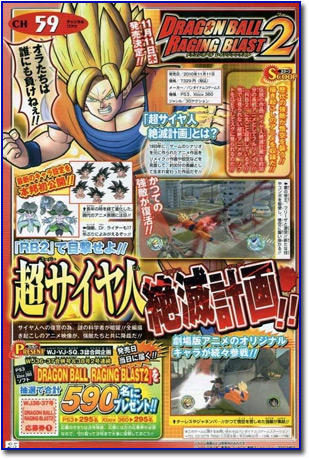
Details were a little sketchy at first, but it confirmed that the original story was being re-created and re-animated from the ground-up (as opposed to scene re-tracing as in Kai, exactly as "Wasted Wisher" had described to us), and would be a special, 30-minute animation available on the Raging Blast 2 game disc right from the start. There was no confirmation at the time as to how much this story would be integrated into the single-player, normal story mode within Raging Blast 2 — it appeared that it would be in some capacity, as the Jump scan inferred that Freeza would fight Goku with new techniques and combos, possibly alluding to the "Ghost Warrior" versions of villains that fight the heroes in the original Saiya-jin Zetsumetsu Keikaku.
On 09 August 2010, Namco-Bandai in Japan issued their own formal press release about the game and this new anime inclusion. The official website for the game was also updated along with character designs and sketches:
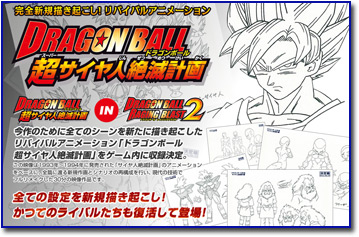
On 10 August 2010, the American branch of Namco-Bandai issued their own press release confirming the inclusion of the animated feature in the international release of Raging Blast 2:
DRAGON BALL®: RAGING BLAST™ 2 TO INCLUDE EXCLUSIVE DRAGON BALL® ANIME EPISODE
Game Disc to Feature Brand New Never Before Seen 30-minute Dragon Ball Anime Feature
SANTA CLARA, Calif., (August 10, 2010) – NAMCO BANDAI Games America Inc. today announced that all retail editions of Dragon Ball®: Raging Blast 2™ for the Xbox 360® video game and entertainment system from Microsoft and PlayStation®3 computer entertainment system will feature a brand new 30-minute feature of the Dragon Ball® anime on the game disc.
The exclusive new feature entitled “Dragon Ball: Plan to Eradicate the Super Saiyans” is a completely reconstructed, re-scripted and re-edited version of an original Japanese episode that has never been released in the U.S or Canada, offering something unique to fans of the series. Everyone who buys the game can watch this exclusive anime straight out of the box.
Dragon Ball: Raging Blast 2 features a host of improvements and new features, delivering the most authentic and advanced Dragon Ball videogame experience to date. Everything from the camera to the controls has been reworked to create an accessible game with more than enough tactical depth to satisfy even the most battle-hardened Dragon Ball fan. Sporting more than 90 characters, 20 of which are brand new to the Raging Blast series, new modes, and additional environmental effects, Dragon Ball: Raging Blast 2 is the next evolution in the home console series.
Via the same trailer, it was revealed that "Hatchihyakku" (adapted as simply "Hatchiyack") would be a fully playable character for the first time, having previously just been a "boss" character in the original Famicom and Playdia games:
Raging Blast 2 (which includes Plan to Eradicate the Super Saiyans) was released in Japan on 11 November 2010, with a North American release a week earlier on 02 November 2010 (Amazon: PS3 / 360).
The North American release included the new feature as an immediately-viewable video file within the bonus portion of the game disc on both consoles. The feature was available exclusively in Japanese with hard-coded English subtitles (the Japanese version contains no subtitles).
No additional release of the feature (DVD, Blu-ray, etc.) has been announced for any region of the world.

[ return to Tidbits main ] |